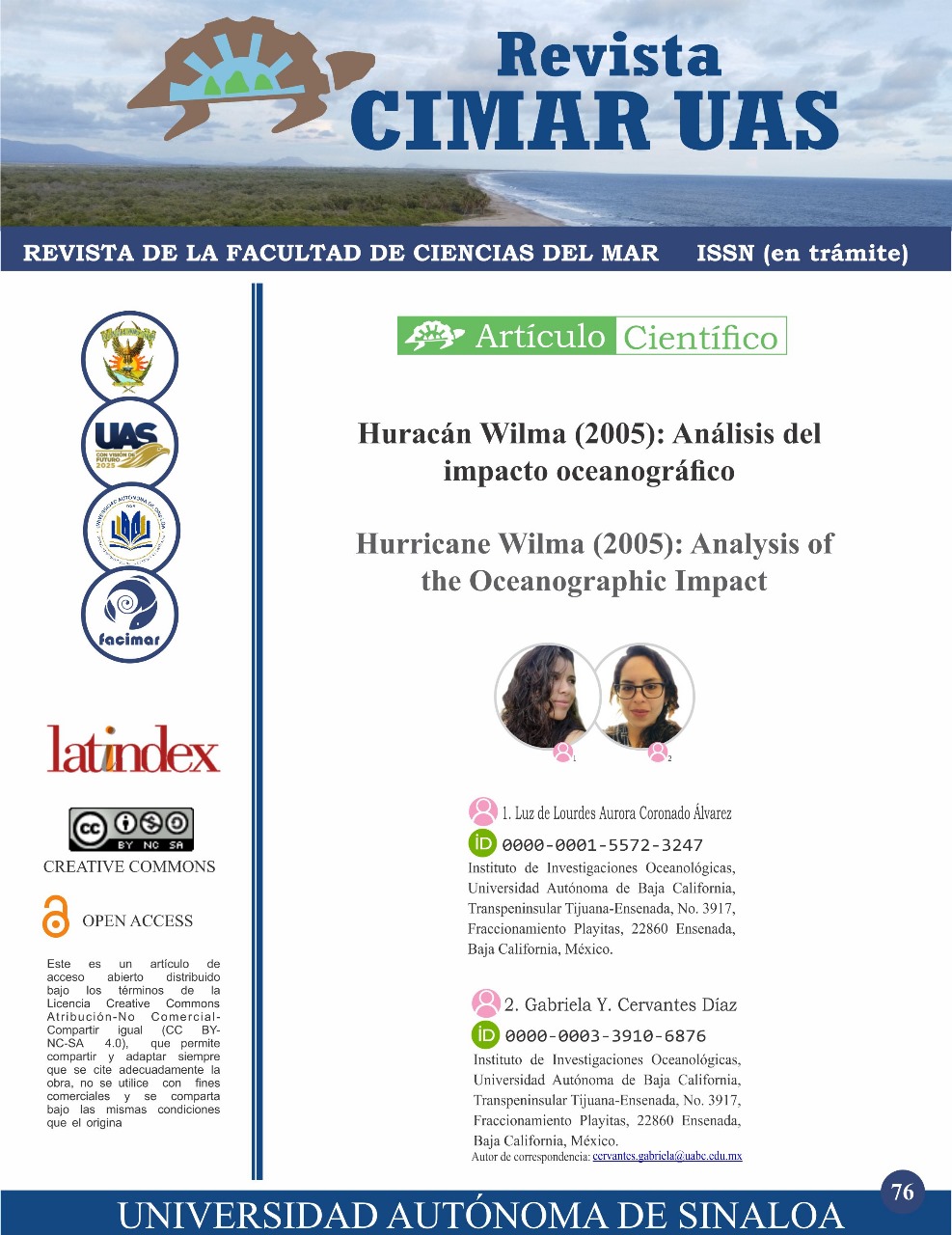Hurricane Wilma (2005): Analysis ofthe Oceanographic Impact.
Keywords:
anomaly, wind, oceanography processes, cyclonic systems, Quintana RooAbstract
Hurricane Wilma had an impact on the oceanographic system of the Mexican Caribbean, causing changes in sea surface temperature (SST), sea surface salinity (SSS), and chlorophyll-a (Chl-a). Satellite data and Bayesian analysis were used to evaluate these changes during the stationary period of the hurricane (October 21 - 23, 2005), when high winds ~240 km h-1 were recorded. A decrease in SST and SSS was observed due to vertical mixing in combination with torrential rainfall (~1575 mm). Chl-a, as a proxy of phytoplanktonic biomass, showed an increase with a lag of 1 to 2 days concerning the passage of the hurricane due to nutrient enrichment. Bayesian analysis allowed us to probabilistically associate the observed changes in SST, SSM, and Chl-a during Wilma's impact in the northeastern portion of Quintana Roo state. These findings highlight the sensitivity of the Mexican Caribbean Ocean system to hurricane changes. This study provides a robust framework for understanding oceanographic responses to such events and offers tools to analyze their impacts under extreme meteorological phenomena.
Downloads
References
Adger, W. N., Hughes, T. P., Folke, C., Carpenter, S. R., & Rockström, J. (2005). Social ecological resilience to coastal disasters. Science, 309(5737), 1036-1039. https://doi.org/10.1126/science.1112122
Alongi, D. M. (2008). Mangrove forests: Resilience, protection, and management. Marine Pollution Bulletin, 56(3), 806-815. https://doi.org/10.1016/j.marpolbul.2008.01.011
Beven, J. L., Brown, D. P., Franklin, J. L., Knabb, R. D., Pasch, R. J., & Stewart, S. R. (2008). Atlantic Hurricane Season of 2005. Monthly Weather Review, 136(3), 1109–1173. https://doi.org/10.1175/2007MWR2074.1
Copernicus Climate Change Service (C3S). (2017). ERA5: Fifth generation of ECMWF atmospheric reanalyses of the global climate . Copernicus Climate Change Service Climate Data Store (CDS), Noviembre 2024. https://cds.climate.copernicus.eu/cdsapp#!/home
CMENS (2014). Global Ocean Gridded L 4 Sea Surface Heights And Derived Variables Reprocessed 1993 Ongoing. Level 4. doi.10.48670/moi-00148
Cutter, S. L., Boruff, B. J., & Shirley, W. L. (2008). Social vulnerability to environmental hazards. Social Science Quarterly, 84(2), 242-261. https://doi.org/10.1111/1540-6237.8402002
Emanuel, K. (2005). Increasing destructiveness of tropical cyclones over the past 30 years. Nature, 436(7051), 686–688. https://doi.org/10.1038/nature03906
Gall, M., Cutter, S. L., & Emrich, C. T. (2014). Risk and resilience: A case study of hurricane resilience in coastal communities. Natural Hazards Review, 15(2), 108-119. https://doi.org/10.1061/(ASCE)NH.1527-6996.0000137
Gierach, M. M., & Subrahmanyam, B. (2008). Biophysical responses of the upper ocean to major Gulf of Mexico hurricanes in 2005. Journal of Geophysical Research: Oceans, 113(C4). https://doi.org/10.1029/2007JC004419
Kates, R. W., Colten, C. E., Laska, S., & Leatherman, S. P. (2006). Reconstruction of New Orleans after Hurricane Katrina: A research perspective. Proceedings of the National Academy of Sciences, 103(40), 14653-14660. https://doi.org/10.1073/pnas.0605726103
Knutson, T. R., Camargo, S. J., Chan, J. C., Emanuel, K., Ho, C.-H., Kossin, J., & Wu, L. (2019). Tropical cyclones and climate change assessment: Part I. Detection and attribution. Bulletin of the American Meteorological Society, 100(10), 1987–2007. https://doi.org/10.1175/BAMS-D-18-0189.1
Lin, N., Emanuel, K. A., Oppenheimer, M., & Vanmarcke, E. (2020). Physically based assessment of hurricane surge threat under climate change. Nature Climate Change, 2(6), 462–467. https://doi.org/10.1038/nclimate1389
Lozano-García, S., Vázquez-Selem, L., & Ortega-Guerrero, B. (2009). Hurricane impacts and recovery in tropical coastal systems. Environmental Geology, 56(3-4), 603-616. https://doi.org/10.1007/s00254-008-1413-3
Martell-Dubois, R., Silva-Casarin, R., Mendoza-Baldwin, E. G., Muñoz-Pérez, J. J., Cerdeira-Estrada, S., Escalante-Mancera, E., & Laiz, I. (2018). Spectral bimodality of waves produced by hurricanes in the Caribbean coastal zone off Mexico. Ciencias Marinas, 44(1), 33–48. https://doi.org/10.7773/cm.v44i1.2717
Nicholls, R. J., Hoozemans, F. M. J., & Marchand, M. (2007). Increasing flood risk and wetland losses due to global sea-level rise: Regional and global analyses. Global Environmental Change, 9(1), S69-S87. https://doi.org/10.1016/S0959-3780(98)00019-9
NASA. (2021). Goddard Space Flight Center, Ocean Ecology Laboratory, Ocean Biology Processing Group. Moderate-Resolution Imaging Spectroradiometer (MODIS) Aqua (Daily Chlorophyll 4 Km Data.) NASA Ob. DAAC, Greenbelt, MD, USA (2021), 10.5067/AQUA/MODIS/LM3/CHL/2018 Accessed on 30/08/2024
Norris, F. H., Friedman, M. J., & Watson, P. J. (2002). 60,000 disaster victims speak: Part I. An empirical review of the empirical literature, 1981–2001. Psychiatry: Interpersonal and Biological Processes, 65(3), 207-239. https://doi.org/10.1521/psyc.65.3.207.20173
Pielke, R. A., Jr., Landsea, C. W., Mayfield, M., Laver, J., & Pasch, R. (2008). Hurricanes and global warming. Bulletin of the American Meteorological Society, 86(11), 1571-1575. https://doi.org/10.1175/BAMS-86-11-1571
Rodolfo Elizondo Torres, (2005). Wilma: testimonio de unidad y cultura de la prevención. Desastres Naturales. Secretario de Turismo, México. https://firstforum.org › wp-content › uploads › 2021/05 › Publication_00134
Ritchie, H., & Roser, M. (2020). Natural disasters. Our World in Data. Retrieved from https://ourworldindata.org/natural-disasters
Sriver, R. L., & Huber, M. (2007). Observational evidence for an ocean heat pump induced by tropical cyclones. Nature, 447(7144), 577–580. https://doi.org/10.1038/nature05785

Downloads
Published
Issue
Section
Categories
License
Copyright (c) 2025 Journal Ciencias del Mar UAS

This work is licensed under a Creative Commons Attribution-NoDerivatives 4.0 International License.

 Cada manuscrito está bajo la licencia Atribución-NoComercial-SinDerivadas 4.0 Internacional (CC BY-NC-ND 4.0). Puedes consultar los términos de la licencia en el siguiente enlace:
Cada manuscrito está bajo la licencia Atribución-NoComercial-SinDerivadas 4.0 Internacional (CC BY-NC-ND 4.0). Puedes consultar los términos de la licencia en el siguiente enlace: 